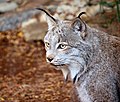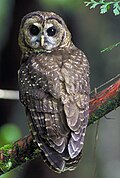Genetic monitoring
Genetic monitoring is the use of
Types
Types of population changes that can be detected by genetic monitoring include population growth and decline, spread of pathogens, adaptation to environmental change, hybridization, introgression and

Two broad categories of genetic monitoring have been defined:
Examples
Estimating abundance and life history parameters – Category Ia
At the individual level, genetic identification can enable estimation of population abundance and population increase rates within the framework of
-
Grizzly bear
-
Brush-tailed rock-wallaby
-
Snow leopard
-
Eastern imperial eagle
Identifying species – Category Ib
Use of molecular genetic techniques to identify species can be useful for a number of reasons. Species identification in the wild can be used to detect changes in population ranges or site occupancy, rates of
).-
Iberian lynx
-
Wolverine
-
Canadian lynx
-
Spotted owl
Species identification is also of considerable utility in monitoring
Although initial applications focused on species identification and population assessments, market surveys also provide the opportunity for a range of molecular ecology investigations including capture-recapture, assignment tests and population modeling.[19] These developments are potentially relevant to genetic monitoring Category II.
-
Dried sea horses
-
Shark fins
Monitoring population genetic parameters – Category II
Monitoring of population changes through genetic means can be done retrospectively, through analysis of
-
Galapagos giant tortoise
-
Atlantic salmon
-
Hector's dolphin
-
Northern leopard frog
Genetic monitoring has also been increasingly used in studies that monitor environmental changes through changes in the frequency of adaptively selected markers. For example, the genetically controlled photo-periodic response (hibernating time) of pitcher-plant mosquitos (
Genetic monitoring is also useful in monitoring the ongoing health of small, relocated populations. Good examples of this are found for
Category II genetic monitoring of population genetic diversity (PGD) of wild species, for purposes of biodiversity conservation and sustainable management, is unevenly distributed among countries in Europe.
-
Barrel medic
-
Common wheat
-
Pitcher plant mosquito
-
Kākāpō – New Zealand night parrot
Status of genetic monitoring in science
In February 2007 an international summit was held at the Institute of the Environment at
In 2007 a
Currently the topic is covered in several well known text books, including McComb et al. (2010) and Allendorf et al. (2013).
Genetic monitoring in natural resource agencies
Many
See also
References
- ^ Website of the Convention on Biological Diversity
- ^ PMID 16962204.
- ^ doi:10.1139/Z04-100.
- S2CID 9147442.
- PMID 17044939.
- S2CID 20787622.
- S2CID 14165843.
- PMID 16827001.
- S2CID 35396299.
- doi:10.1139/F03-125.
- S2CID 85843341.
- S2CID 16786563.
- PMID 16494532.
- PMID 18270161.
- S2CID 205781444.
- S2CID 16072813.
- S2CID 43989899.
- doi:10.1016/j.jembe.2005.12.002. Archived from the original(PDF) on 2011-07-16. Retrieved 2009-04-01.
- ^ PMID 18643915.
- S2CID 25938493.
- S2CID 86541791.
- S2CID 15874239.
- S2CID 26719257.
- S2CID 27134675.
- PMID 18809928.
- doi:10.1139/F05-260.
- PMID 28565198.
- PMID 9383067.
- PMID 12185245.
- S2CID 23598245.
- S2CID 4988537.
- S2CID 4336347.
- PMID 10670959.
- S2CID 44258175.
- S2CID 22607075.
- ^ S2CID 52249993.
- PMID 16243699.
- S2CID 20349824.
- S2CID 28250600. Archived from the original(PDF) on 2016-03-03. Retrieved 2009-04-01.
- S2CID 12815666. Archived from the original(PDF) on 2010-06-03. Retrieved 2021-06-12.
- S2CID 23585208.
- PMID 17956396.
- PMID 11698659.
- S2CID 7810825.
- PMID 18194165.
- S2CID 84475847.
- S2CID 8877634.
- S2CID 266998582.
- ^ "A Report on the Results and Recommendations of the International Summit on Evolutionary Change in Human-altered Environments" (PDF). Archived from the original (PDF) on 2010-07-11. Retrieved 2009-04-01.
- ^ National Center for Ecological Analysis and Synthesis
- ^ The National Evolutionary Synthesis Center
- ^ "Genetic Monitoring: Development of Tools for Conservation and Management". Archived from the original on 2009-06-15. Retrieved 2009-04-01.
- ^ Rocky Mountain Research Station Wildlife Genetics Laboratory
External links
- Genetic Monitoring For Managers
- Science Centric Report of Grizzly Bear study in northwest Montana[permanent dead link]
- New Scientist Article – Snow leopard numbers can be read in their scat
- Animals' scat is scientist's treasure: Advances in DNA testing let wildlife biologists study creatures using what they leave behind
- Post Gazette News: Aviary researcher finds Eagles need a closer look
- New Scientist- Hidden Populations give Lynx a fighting chance
- SFGate: It's True – wolverine is thriving near Tahoe
- Associated Press: Protected Trout is breeding itself into Extinction
- Adapting to a warmer climate: the purple pitcher plant mosquito



















